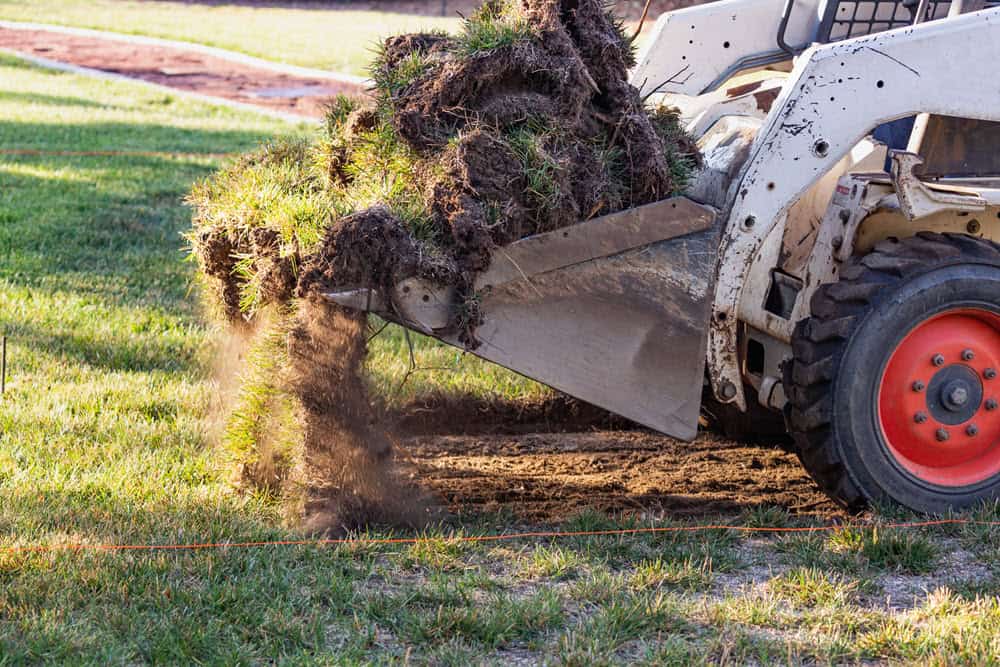Landscape Grading and Contouring in Austin
A DIY Grading Project Takes a Lot of Time, Money, and Heavy Equipment
Proper land grading your property is crucial for establishing a solid base and directing water flow away from your property and neighboring properties. This practice ensures optimal moisture management, discouraging the pooling that leads to issues such as erosion, unwanted pests, and mold.
Soil Grading and Stability Enhancement
Creating the Right Slope
Effective soil grading means establishing a moderate slope in your yard. This helps in water flow away from structures and prevents pooling. The current slope is checked for the existing grade. The ideal grade is about a 2 to 3 inch drop for every 10 feet as you move away from your property.
Ensuring Proper Drainage
Good drainage protects landscapes from water damage. Your contractor will conduct an assessment of how your lawn drains. They’ll look for low spots where water may be pooling and may recommend French Drains or Retaining Walls as part of the solution.
- French Drains – French drains are trenches that are around 18-24 inches deep. The trench is sloped away from your house and towards an area where water won’t cause damage to your property or neighboring properties. A drain collects water that is carried away by the french drain pipe.
- Retaining Walls – Retaining walls have multiple benefits for your property. Retaining walls are typically constructed of solid, interlocking concrete blocks. They’re able to prevent erosion, support soil, and keep slopes in place. They also offer the wonderful benefit of adding more usable space to your property. Oftentimes there will be a french drain at the base of a retaining wall to alleviate the effects of water draining towards the wall. This water that would otherwise collect at the base of the retaining wall is carried away by the French Drain.
Incorporate Trees and Plants into Your Landscape Design
To assist with proper drainage, your contractor may recommend the use of trees and plants to assist in anchoring the soil, prevent erosion, and assist in the overall land grading efforts. Greenery also helps to absorb excess water. Native trees and plant species work best as they’re already well positioned to thrive in Austin’s climate and are much less likely to need replacement when compared to non-native species.
Larger Land Grading Jobs May Require Excavation
Leveling tasks that don’t require major land transformation can generally be done by a landscaper. Depending on your situation, you may need more extensive land grading services like excavation. This will result in a more extensive construction project that will likely involve in land clearing and can significantly alter your property.

More Extensive Land Grading Projects May Require Heavy Equipment and an Excavating Contractor to Achieve Proper Slope
Excavation services are needed for larger projects where a lot of dirt needs to be excavated and relocated in order to create the proper slope and achieve a usable property. Excavation contractors use heavy equipment to move large quantities of dirt on your land to achieve the proper grade.
Frequently Asked Questions
What factors influence the cost of landscape grading services in Austin?
The cost of landscape grading services in Austin depends on several factors. These include project size, soil type, the amount of grading needed, slope steepness, and whether any obstacles (like rocks or tree stumps) need removal. Access to the project site, labor costs, and any necessary permits may also affect the overall price.
How do I choose the best residential landscape grading company?
Give us a call or fill out the form below and we will put you in touch with a qualified landscaper who performs grading services.
What is the typical process for residential landscape grading?
Residential landscape grading usually involves several steps. First, an assessment of the property is needed to determine the scope of work and identify potential issues. Then as part of overall site prep, soil is removed or added to create the desired slope and grade. The grading process involves leveling and shaping the land to promote proper water runoff and prevent erosion. Finally, the area is compacted to create a stable base for planting, hardscaping, or construction.
How can proper landscape grading improve drainage and prevent erosion?
Proper landscape grading ensures that water drains away from foundations, reducing the risk of water damage and flooding. A well-graded yard also helps prevent soil erosion by directing water flow to appropriate drainage systems or areas. By promoting efficient water management, grading can protect your property from potential issues such as standing water, mudslides, and soil displacement.
Landscape Grading
Proper Grading Can Prevent Water from Channeling Towards Your House.

DIY Yard Care
Check out our blog for information on how to do upkeep around your yard. Tips and tricks for keeping your lawn, plants and trees healthy.

Austin Events Calendar
A monthly listing of the events for you and your family to enjoy in and around Austin

COMPLETE LIST OF ALL SERVICES
All Services
Click a Link Below for More Information About Services Provided
Hardscaping
Curbing
Decks
Fence Maintenance & Install
Fire Pits
Landscape Lighting
Outdoor Kitchens
Patios
Pergolas & Gazebos
Retaining Walls
Walkways
Sprinkler Systems
General
Fall Cleanup-Leaf Removal
Landscape Design
Mulching
Organic Landscaping
Spring Cleanup
Water Features
Xeriscaping
Trees, Shrubs & Perennials
Flower Beds & Planters
Hedge & Shrub Trimming
Stump Grinding
Tree Planting
Tree Removal
Tree Trimming & Pruning
Lawn Maintenance
Lawn Aeration
Lawn Dethatching
Lawn Edging
Lawn Fertilization
Lawn Mowing
Pest Control
Weed Control
Drainage Issues
Sod & Turf
OUR SERVICE AREA
Serving Austin and Surrounding Suburbs
The perfect Austin landscaper for your needs.
For more information, click on your community below
LET’S GET STARTED
Contact Us
Austin Landscaping Lynx
Phone:
512.357.7927
Email:
operations@austinlandscapinglynx.com
Hours:
Sun – Sat: 8am – 6pm